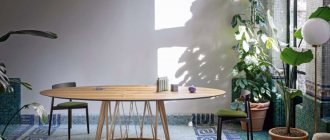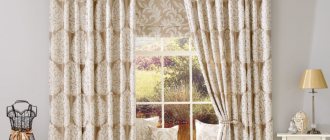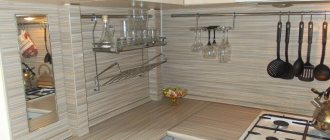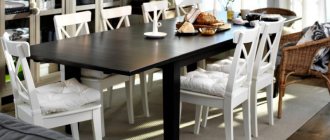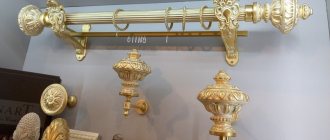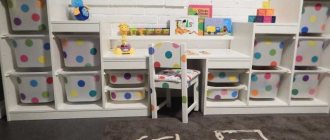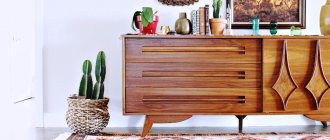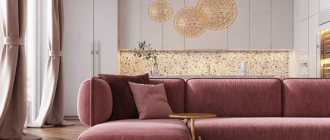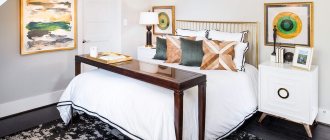Types, brief description
In the design and installation of wallpaper, not only the successful choice of pattern and color is important, but also the material from which the coating is made.
Paper wallpapers are the cheapest, short-lived, they are afraid of moisture, fade in the sun, and are difficult to hang because they get wet and shrink. Non-woven ones have a higher density. Essentially it is the same paper, but with fabric fibers. They look more impressive, do not shrink after drying, do not swell, and some models can be painted.
Vinyl wallpaper has a paper base and a vinyl coating with different thicknesses and densities, which makes it moisture resistant and provides good performance. Vinyl coatings come in several types: volumetric (foam); washable (kitchen); flat (silk-screen printing). Textile wallpaper belongs to the luxury class and is an exquisite wall decoration. The front surface is fabric. The coating requires careful care.
Fiberglass wallpaper is made with the addition of minerals. They are very durable and have a beautiful textured surface. Most often they are monochromatic. Linkrust is paper-based wallpaper with a three-dimensional pattern, which is created by applying mastic. Externally, they look as if the walls were covered with plaster stucco.
Attention! Liquid wallpaper, although called wallpaper, is a completely original coating. This is a dry fluffy mass, which is diluted with water before application and applied to the wall like putty.
Textured
Textured wallpaper is distinguished by a rough or embossed coating; the very concept of “texture” helps to characterize the surface. The relief can be: large (the volume is visible from afar), medium (the volume is noticeable upon close examination), small (visually merges, but is clearly noticeable to the touch).
The undoubted advantage of textured coatings is that they hide uneven walls, look expensive, and have no design restrictions. Wallpaper can be textured from any material, from paper to fiberglass.
Attention! The concepts of “texture” and “texture” are very similar. The difference is that the texture can be determined by touch and visually. The lower limit of texture is a smooth surface, the upper limit is visible relief. The texture can only be determined by touch. Most often, the word “texture” describes products that imitate the surface of wood, fabric, or stone.
Smooth
Coatings with a smooth surface can be found less and less often in modern interiors. Although in terms of quality and brightness they may not be inferior to their textured counterparts. The choice of smooth wallpaper is primarily a matter of taste.
With texture
Not every interior can withstand natural materials: the bare brick of a spacious loft, the untreated wood of a country house or heavy stone love an open layout. But even for residents of top apartments, designers can offer a solution - wallpaper that imitates natural material.
Modern imitation is quite realistic with finely detailed details. In any case, it is worth considering that creating a real atmosphere with the help of unreal objects is very difficult. The resulting interior will be a little ironic, but perhaps this is exactly what needs to be achieved.
Wallpaper for walls that imitates natural materials will help create the necessary impression, but they need additions, furniture, and accessories that will make them even more realistic.
Plain
Plain wallpaper is an alternative to painting. Their advantage over painting is that the surface to be covered does not need to be prepared so meticulously. The paint will highlight every bump and hole, the walls should be perfectly plastered and sanded. Whereas wallpaper allows you to hide some unevenness.
Unlike painted surfaces, they can be textured. The color can be slightly adjusted by dyeing. In the interior, they are successfully combined with other finishing materials or patterned wallpaper.
With drawings
You could devote more than one book to wallpaper with patterns, they are so diverse. Different images and palettes make the room brighter or, on the contrary, darken it.
A pattern can mean any pattern, ornament, or repeating picture. The pattern can be small or large, neutral or variegated, smooth or embossed.
If the drawing contradicts the style of the room or purpose, the interior will never be comfortable. You should not combine different designs in one room, even if they are thematically similar or compatible in color scheme. But they can be diversified with plain walls or stripes.
For convenience, patterned wallpapers are divided into groups according to image type.
- Abstract drawings - stains, strokes, chaotic spots are perfect for modern interiors;
- Geometric shapes - various figures and circles. As a result of a specific alternation, a certain mood and rhythm are created. Used in modern styles, especially large forms;
- Stripes are a type of geometric pattern. They can be vertical and horizontal, narrow and wide, can be used in almost any style, especially complement modern and retro;
- Floral pattern - all kinds of twigs, leaves, flowers, other floristry. It is attractive because the pattern is unobtrusive and suitable for most styles. Looks especially good with country and Provence;
- Oriental designs are thematic images of different styles, for example, tropical animals, Chinese characters, Arabic patterns. Suitable for ethnic or eclectic interiors;
- Imitation drawings - this type includes any images that imitate a certain material (wood, stone, metal);
- Classic pattern - represents various regular patterns, most appropriate in classic interiors, although with modern interpretations the patterns can be attributed more to modernism.
With stripes
Stripes on the walls are a fashion trend that certainly deserves attention. Alternating contrasting colors always attracts attention.
Stripes can be used almost anywhere. They can be fancy, intricate, moderate or subtle. The main thing is that there are other details of furniture or textiles that complement them.
In bright colors, stripes will bring dynamics and make the atmosphere more lively. Wide ones will give the spirit of modernity. A vertical line will visually raise the ceilings, while horizontal lines, on the contrary, will make the walls wider. Narrow stripes look better in small rooms, while large stripes look better in fairly spacious ones.
A wide vertical stripe will be appropriate in a classic interior, a narrow one will very elegantly complement pop art or retro, and any minimalist interior will be decorated with a striped covering in black and white or gray.
In a cage
Checkered wallpaper is often preferred by lovers of strict motifs. Designers love them for their ability to saturate a room with a bright contrast of simple shapes, as well as make the decor more impressive. The cell can be different: bright, traditional, strict, large, small.
Checkered patterns are most often used to decorate retro interiors, as well as in English and classic styles. Varieties of checkered patterns:
- Chess - classic strict squares of two or more contrasting colors;
- Scottish check - squares are created by perpendicular stripes of varying widths;
- Country is a type of Scottish check with less contrast;
- Nova - a square pattern of four colors;
- Glencheck is a complex geometry of dark and light shades on a gray background.
Wall photo wallpaper
Modern photo wallpapers are no longer the same birch grove or waterfall; they are high quality images on practical, durable materials. It is not necessary to select options from the catalog. Photo wallpaper can be any image or even a child's drawing. This small canvas can radically transform a room.
The image on the photo wallpaper can be as realistic as possible, as if there were no walls in the room at all. Or it may look like a huge painting.
The realistic panorama – voluminous 3D photo wallpaper – deserves special attention. They look very original and interesting, the volume and depth push the boundaries regardless of the size of the room.
With patterns
Wallpaper with patterns was one of the first to appear and has never gone out of fashion since then. They are presented in the form of an interweaving of geometric shapes, ethnic ornaments, classical coats of arms, and oriental motifs. Almost every home has a room with patterned wallpaper. This pattern is considered the softest.
Classic wallpapers have become especially popular lately: patterns with monograms, damask and paisley.
With damask pattern
Damascus is not only a steel with a special texture or the capital of Syria, it is also an original two-color pattern with an attractive oriental motif. It is very easy to recognize. Damask consists of vertical rows of a diamond-shaped symmetrical floral pattern, which is composed of floral motifs and ornate lines.
Wallpaper with a damask pattern is usually made in subdued colors. At the same time, they are distinguished by elegant severity. Can be smooth or embossed. The coating looks original when a metallic pattern stands out against a matte background. Damask pattern goes well with plain walls or complemented by vertical stripes.
The classic use of damask is as an accent wall. The room is filled with companion items: a mirror, a pouf, a pillow. It is worth considering that damask almost always makes the overall background heavier. It can be used indoors for any purpose, but it does not suit every style. Ideally complements classics, oriental style, modern.
With monograms
Wallpaper with monograms is perfect for the living room and bedroom. In rare cases, they are used to cover the walls of hallways. Used to decorate all horizontal surfaces or highlight individual zones.
It is important to take into account that the monogram pattern can have both a classic and modern look. The perception of this type of wallpaper largely depends on the lighting of the room. Wallpaper with monograms will help create accent areas and combine well with many other materials, since it does not have the pretentious high cost that is inherent in the classics.
By alternating the pattern across the entire surface of the wall, a dynamic effect is created. A combination of striped walls with sections of wallpaper decorated with monograms can be very successful. They are absolutely not suitable for small rooms, unless they highlight one narrow wall.
With paisley pattern
Paisley is also called Turkish or Indian paisley. This pattern has already become a classic and has many interpretations. It consists of drops of various shapes and designs, often with ornate floral designs. The cucumber pattern is considered most suitable for the bedroom, living room, office, where it creates an atmosphere of wealth and mystery.
Classic paisley involves the use of two, maximum three colors, but in modern design it can be more variegated and rich. In addition, other patterns are often added to the drops.
With stories: what is it and how is it used in the interior
Wallpaper with themes is also called graphic or art wallpaper. To put it simply, this is wallpaper with pictures. A real find for designers, which allows you to decorate the interior in accordance with the chosen theme. Thanks to them, a fairy tale story comes to life on the walls. A comic book, a plot from a favorite song or movie will diversify the modern interior, and perhaps a drawing based on a famous work of art will appear.
Wallpaper with a plot is somewhat reminiscent of photo wallpaper, but in this case, not one picture is depicted, but a report (a basic element of the ornament that is repeated many times) in the form of a drawing or graphic object. The subject matter of the wallpaper can be very diverse. Most often they are created for children's rooms. In other rooms, story-based wallpaper is less in demand. Wallpaper with a theme can cover all walls or be used to highlight an accent wall. In any case, it is important that the thematic design matches the overall style and purpose of the interior.
Art wallpaper can also be glued in small rooms, but they are more suitable for spacious rooms, where the pattern will not be blocked by bulky furniture and can be appreciated.
In the form of frescoes
Fresco is one of the wall painting techniques where the drawing is created on wet plaster. After drying, the lime that was previously added to the composition forms a transparent film that protects the fresco from the effects of time. Today, more and more often, any wall painting is called a fresco, regardless of the technique of its production.
When people talk about wallpaper in the form of frescoes, they most often mean ready-made panels with aged images or ordinary photo wallpaper.
With text and inscriptions
They appeared relatively recently. The print is very popular in teenagers' bedrooms, but this does not mean that it cannot be used in other rooms. A variety of designs and themes allows you to choose the appropriate option for any room.
There are many design options. Inscriptions can be made in calligraphic font, consist of individual phrases, letters, numbers, in a native or foreign language. The stylization of street graffiti or a collage of old newspaper clippings looks interesting. The themes of such wallpapers are impressively diverse: retro drawings, mathematical calculations, a rambling set of words, children’s “calligraphy,” imitation of old letters. In general, they look original, and sometimes even extravagant.
Wallpaper for plaster - what is it, features
In fact, these are standard finishing strips, but they completely recreate the effect of plastered walls. The peculiarity of the wallpaper is its texture. It is created by embossing or spraying polymers.
Manufacturers produce several types of wallpaper for the types of textured plasters. Thanks to the relief design, the coatings create an atmosphere of luxury or minimalism, aristocracy or rustic comfort.
The relief pattern is not intended for rooms where there is high humidity; there is a high risk of contamination.
In fact, these are standard finishing strips, but they completely recreate the effect of plastered walls.
Advantages and disadvantages
The positive properties of wallpaper include decorativeness. On a paper, fiberglass or non-woven basis, textures are recreated that are beyond the capabilities of beginners. Dreams become reality.
You can create luxurious interiors yourself, without the involvement of specialists. There are wallpapers with the effect of aged walls, Venetian plaster with mother-of-pearl and gilding. Lovers of minimalism choose concrete finishes and decorative plaster with shallow relief.
The disadvantages of wallpaper include the fragility of vinyl and the poor moisture resistance of paper. The materials have no other significant disadvantages.
You can create luxurious interiors yourself, without the involvement of specialists.
Wallpaper or plaster, which is better, comparison
Although a categorical answer to the question of which is better is impossible, apartment owners more often choose wallpaper. For decorating cafes and other rooms where there are a lot of people, plaster is more practical.
What are the advantages of decorative canvases:
- Unlike natural finishes, wallpaper with a plaster effect is easier to apply.
- Repairs require less time.
- Wallpaper that imitates a convex plaster layer will not leave scratches, the material is soft and elastic.
- There are no visible joints on the texture stripes; they look uniform.
- The canvas, unlike plaster, does not fade under the influence of ultraviolet radiation.
Considering the ease of installation and low cost of wallpaper, plaster loses in all areas. Plastering is always more difficult than wallpapering.
By purchasing textured roll products, repairs can be done in 1–2 days. Pasting will take several hours. Preparing walls for plastering takes weeks; you need to wait until the walls dry out.
Unlike natural finishes, wallpaper with a plaster effect is easier to apply.
Combination options
You can combine wallpaper in the interior in different ways, but among all the methods you can identify the most popular design techniques:
- Horizontal division - a plain or striped surface at the bottom, and a large or small pattern at the top;
- Alternating vertical stripes and a large pattern - on a striped background there are wide areas with a print.
- They are usually located on opposite walls and can be asymmetrical;
- Highlighting an area with texture or color;
- A combination of wallpaper with other finishing materials.
Advice! It is desirable that the combined wallpaper belong to the same series or at least match the color and thickness of the material.
How wide is wallpaper for walls?
The width varies depending on the country of manufacture of the products. More often there are several options for wallpaper sizes. The popular width is 53 cm. Most manufacturers stop at this value. The 70 cm width is often used by European factories. Meter-sized products are also used. The width is 106 cm. Wallpaper reduces the number of joints, making the surface of the walls uniform.
The popular width is 53 cm.
Accent wall
This design technique has already become a classic. As the name implies, it is designed to attract attention; there should be only one in the room; in very rare cases, a complementary pair is allowed. When decorating accents, there is color contrast, but you can also play on texture or highlight the wall with photo wallpaper. In any case, the color had to be brighter and more saturated than on the other walls.
If we are talking about plain wallpaper, the color of the accent wall should be the leading one. In bedrooms, it is customary to make the accent wall at the head of the bed. In the kitchen - near the dining area, and in the living room there is a free surface or TV area. In children's rooms, a play area is used as an accent wall, in the bathroom there is a wall near the bathtub, and in the hallway there is a surface opposite the entrance.
What kinds of wallpaper are there for walls - where is it best to use them?
In each room it is necessary to use the type of covering suitable for the conditions. The choice is influenced by the characteristics of the room and the characteristics of the cladding. In addition to standard materials, there are moisture-resistant materials that can withstand the effects of wet cleaning. For rooms with a high probability of contamination and humidity, it is recommended to choose detergent or super-cleaning products. They can be washed using non-aggressive cleaning agents. They line the nursery, hallway, bath and kitchen with these.
An important factor is resistance to burnout. The more rays of light penetrate the room, the higher this indicator should be for the wallpaper.
For rooms with a high probability of contamination and humidity, it is recommended to choose detergent or super-cleaning products.
Design
There are no strict rules in interior design and especially in choosing wallpaper. However, the experience of professionals, gained through trial and error, allows you to choose the most successful option for different rooms.
For the bedroom
The bedroom should be calm and cozy, so preference should be given to neutral wallpaper. The bed area can be successfully highlighted with wallpaper that can extend onto the ceiling. From the remains of these battles, you can make a panel on the opposite wall or use them to cover a niche.
It is undesirable to paste photo wallpapers in the form of landscapes in the bedroom, but flowers or a cage will come in handy here.
For kitchen
In the kitchen, wallpaper should be combined with the finish that is used on the work wall. Symmetrical zoning looks very good when the kitchen walls are covered with wide stripes and complemented with a bright print on the most noticeable open wall.
The design of the kitchen walls should not be too colorful; sometimes it is better to give preference to plain, smooth surfaces. The print must correspond to the kitchen theme, and the color of the pattern or its individual elements must necessarily find a visual response on the facade of the furniture. It is not advisable to use photo wallpaper in kitchens with a bright apron.
For children's
In children's rooms, the combination of plain walls with photo wallpaper looks very harmonious. There are many collections for children with small patterns, but covering all the walls with them is strictly not recommended. It is best to alternate a small pattern with wide stripes or plain surfaces.
For the living room
The living room is a place where you can realize your wildest fantasies. The room can be a colorful palette of an artist or a restrained classic interior. Here you can use textured wallpaper with a large damask pattern, which will complement massive furniture or a small flower and stripe in pastel colors. The combination will bring lightness and spaciousness to the atmosphere.
For the living room, you can choose almost any wallpaper design you like and create the most original combination.
It is very difficult to independently develop a wallpaper design for a room without having an idea of what materials, colors and textures there are, without knowing about the rules for combining and combining colors. But if you delve even a little deeper into these issues, use your imagination and look through many ready-made designer interiors, you will probably be able to create your own that will satisfy all aesthetic needs.
Classification by material of manufacture
Types of wallpaper for walls are divided according to certain characteristics, including the material of manufacture. Each type has certain characteristics. Manufacturers are constantly developing and releasing new products that are striking in appearance and in their characteristics.
Types of wallpaper for walls are divided according to certain characteristics, including the material of manufacture.
Classic paper
The base is paper with a pattern applied to the surface. Lightweight, environmentally friendly, easy to apply. Recommended for use in rooms with normal humidity. They have low cost and are able to pass air flows. The disadvantages include the absorption of odors, the need for careful care, lack of moisture resistance and resistance to fading. Careless handling leads to damage to the material and breaks easily.
Recommended for use in rooms with normal humidity.
Vinyl
The paper base is covered with a finishing vinyl layer. Suitable for cladding the kitchen space and hallway. Wear-resistant, durable, resistant to wet environments, durable. Proper care allows products to last up to 10 years. They are attractive due to their relief structure, which hides some minor surface defects. There may be problems with pasting; wallpaper is expensive and cannot allow air to pass through, causing the formation of mold.
Wear-resistant, durable, resistant to wet environments, durable.
Non-woven wallpaper with non-woven coating
The non-woven base is environmentally friendly and safe for health. Suitable for subsequent painting. The canvas breathes, hides wall defects, and withstands exposure to a humid environment. After pasting there is no shrinkage. Durable, do not accumulate dust, easy to clean. No special skills are required for pasting. The glue is applied to the wall, not to the canvas, which simplifies the work. High quality products are expensive, the relief layer is easy to damage, so it is better not to use it in a nursery.
The canvas breathes, hides wall defects, and withstands exposure to a humid environment.
Fiberglass - what is it?
The base is fiberglass fabric, supplemented with sand, soda and other materials. Suitable for subsequent painting. Natural materials in the composition make the product more natural. Strong, durable, resistant to wet environments. They mask unevenness and wall defects, do not absorb odor, and are fireproof. Design choices are limited.
Natural materials in the composition make the product more natural.
Textile (fabric)
The species has existed for a long time, but gained popularity relatively recently. Rice or unbleached paper is used as a base. A layer of natural material, such as bamboo or reed, is applied to it. They hide wall defects, are environmentally friendly, and provide heat and sound insulation. The cost is high, there are difficulties when pasting, they fade, and do not tolerate direct sunlight. For high-quality care, treatment with a special product is required.
It is not recommended to clean natural products from dust using wet cleaning. It is better to use a soft brush or vacuum cleaner.
They hide wall defects, are environmentally friendly, and provide heat and sound insulation.
Flock or velor
The wallpaper resembles velvet. They add warmth and comfort to the atmosphere of the room. They look luxurious, have a wide range of shades, are resistant to sun exposure, and help increase sound insulation. For care, use special brushes or a vacuum cleaner. The material quickly accumulates dust, absorbs odor, is not wear-resistant, not moisture-resistant.
They add warmth and comfort to the atmosphere of the room.
Metal wallpaper
The basis is paper or non-woven fabric. The finishing layer is aluminum foil as decoration. Elite wallpaper used in high-tech and similar styles. Long service life, resistance to fading and humid environments, easy maintenance, noise absorption, can reflect electromagnetic radiation, and look original. They do not allow air to pass through, they are expensive, and for gluing there must be a perfectly flat base.
Long service life, resistance to fading and humid environments, easy maintenance, noise absorption.
How to properly apply natural wallpaper: useful tips
Let's give some useful tips that will come in handy when gluing wallpaper from natural materials:
- The canvas can be cut across with a regular knife , and along with metal scissors.
- Before starting work, the roll should be unrolled and allowed to “rest” so that the material adapts to the indoor climate.
- No need to paste wallpaper over old ones . It is better to properly prepare and prime the walls.
- It is necessary to choose the right combination of shades . For natural wallpaper, only a slight deviation of the color scheme from the main one is permissible.
- For gluing, regular universal wallpaper adhesive or a compound for vinyl materials is suitable.
- Be careful when handling glue . The front surface should be protected as much as possible from its contact.
- When working with heavy canvases (roll weight more than 3 kg with a length of 10 m), it is worth applying an additional layer of glue.
- The first strip of wallpaper is always glued “ from the light ” (from the window), strictly maintaining verticality using a plumb line or level.
- At the window, the canvas is glued so that the edge protrudes by 1-3 cm . Next, the edge is bent, forming a break, and carefully cut to the required size.
Before starting work, switches and sockets must be dismantled, and then holes of the required shape are cut for them.
Technology for the production of natural (plant) wallpaper
Probably, in modern conditions (when technology and mechanization are developed) this will sound wild, but natural wallpaper is made by hand. Using special technology, the plants are dried and then sorted. After which they are carefully laid out on the substrate according to a certain layout pattern. The backing can be papyrus or paper. At the last stage they are glued to the substrate.
Naturally, many companies use their own technologies for the production of natural wallpaper, but the existing template remains relevant for all types of this category.
Wallpaper in retro style in the interior
Quite often when designing a room, customers express a desire to decorate the living room interior with wallpaper in the Art Nouveau style. The concept of Art Nouveau style implies a general movement that covered all directions in culture, art, architecture, and music of the late 20th and early 21st centuries. The word “modern” itself is translated from French as “modern”. This translation largely characterizes the style, since it became a new, fresh trend in the cultural world of those times, and the prerequisite for it was the technical revolution with its scientific progress. The main principle of modernity is the rejection of straight lines and sharp corners in favor of smoothness and plasticity. This was also reflected in the direction of the work of wallpaper company artists; the catalogs are full of wallpaper designs for apartments. Modernism strives for everything new; it is characterized by the ability to combine practical and aesthetic aspirations. This style was reflected in wallpaper collections; it differed in its characteristics in different countries. In the USA, for example, its main slogan was being closer to the environment, and in Austria and Germany, the presence of stricter geometric lines became a distinctive feature of modernity.
Modernism in wallpaper design and living room interior design remains popular to this day. Modern designers in their ideas perfectly play with the basic rules of this style, introducing new, interesting execution techniques and elements.
When arranging the living room of a house in the Art Nouveau style, the main thing is to take into account that Art Nouveau, first of all, is focused on the individual, her individual aspirations and desires. Thus, with the help of this particular style you can express your extraordinary personality in the interior of your home.
The first thing that catches your eye when you see an interior in the Art Nouveau style is the smoothness of all its lines, the absence of any sharp outlines or harshness. It is closer to nature with its plasticity, use of natural materials, and floral patterns than, for example, strict and cold classicism. At the same time, the design of a living room in the Art Nouveau style is a kind of luxury that is skillfully combined with comfort. One of the main features of modernity is the desire to combine different cultural and stylistic techniques, but at the same time, the main thing remains the harmony of the overall picture, which is very important in modernity.
Retro style finish
What is needed for this
Bedroom interior in shabby chic style
- To create a spirit of antiquity in your apartment or a separate room, there are basically three ways, and the first of them is to purchase antique furniture and make drapery on the walls with heavy materials . The effect will be amazing, but the price of such an interior will shock you no less - such things are very expensive and only very rich people can afford them. Therefore, in order to furnish our home in a retro style, we need to find other ways that will raise the average income, and such ways exist.
- One of the easiest methods in terms of labor costs is to simply purchase antique photo wallpapers and stick them in your room, furnishing it accordingly . Another method is cheaper, but it involves some risk, since it requires good taste and imagination - this is creating such wallpaper with your own hands from scrap materials.
Photo wallpaper in shabby chic style
Explanation. Translated from English, the phrase “shabby chic” means “shabby shine” or “shabby chic”. In good old England, thrifty citizens bought worn-out furniture and repainted it to give it a decent look.
Boudoir in shabby chic style
At one time, shabby chic was strongly influenced by the vintage style (from the French vintage, which means old, perennial wine) and, in fact, shabby became a mirror image of vintage - the interior began to take on the appearance that these items had survived several generations and became antiques. This is where we need wallpaper on the walls in the interior that could reflect the spirit of the past with its way of life and morals.
Imitation of drapery
Modern methods of finishing work indoors provide wide scope for experimentation, because retro is not a design instruction, but a constant search for a long-forgotten original. If we talk specifically about wallpaper, then, of course, you need a slightly worn background that corresponds to the time, but you will have to experiment with the selection of texture - it could be painting, decorative finishing plaster, linen or canvas. A very effective option could be an imitation of a tapestry from the time of Louis XIV or images of the architecture of those times - temples, fortresses, castles.
Imitation of old masonry
The look of dilapidated brickwork perfectly reflects antiquity, and here, too, a variety of options are possible. So, such masonry can occupy all the walls of the room along the perimeter, but it can also be an image of an old building or its fragment. The whole point is that all this will have a shabby appearance, without bright colors and glossy shine.
Old newspapers
Stylish wallpaper Elysium
Many people remember the times when, before installing wallpaper, walls were covered with newspapers - this not only created conditions for good adhesion, but also leveled the surface instead of putty - they were glued to flour diluted with water - paste (very often it was just a gift for mice).
But nowadays, the look of old media prints evokes deep respect and this is exactly what designers took advantage of by coming up with wallpapers like the one in the photo above.
The effect of old newspapers on photo wallpaper
Indeed, you can purchase rolls or sheets of wallpaper with images of vintage media, but it is possible to make such a design yourself, only for this you will need the material. Such newspapers can be purchased at flea markets, and they can be pasted in a chaotic manner, overlapping.
Discography of bygone times
A good option would be covers from CDs of former popular artists or posters with similar images. Here, too, there are two options - either you buy ready-made wallpaper with such a print, or create such a collage yourself, using flea markets as a source of materials.
Additional accessories
Living room
But if you stick retro-style wallpaper on the wall, this does not mean that your whole room will suddenly be transformed and you will feel the spirit of a certain time; on the contrary, it may turn out to be something superfluous and unnecessary. The thing is that in such cases you will definitely need some additional accessories such as tablecloths, napkins, vases, boxes, bed linen, paintings, frescoes and so on.
Only by arranging such elements can you achieve the feeling of a certain period of time.
Note. You can make some accessories yourself, using the old English tradition of shabby shine - for this you will have to find old furniture from before and after the revolutionary period that people have and sometimes just throw it away. But it will have to be repaired and updated, because antiquity is not at all synonymous with junk.
In conclusion, I would like to say that creating a retro-style interior cannot be cold - it should exude romance and comfort. Perhaps this is the main goal of this design.
